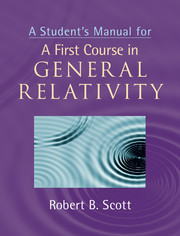Book contents
- Frontmatter
- Contents
- Preface
- 1 Special relativity
- 2 Vector analysis in special relativity
- 3 Tensor analysis in special relativity
- 4 Perfect fluids in special relativity
- 5 Preface to curvature
- 6 Curved manifolds
- 7 Physics in curved spacetime
- 8 The Einstein field equations
- 9 Gravitational radiation
- 10 Spherical solutions for stars
- 11 Schwarzschild geometry and black holes
- 12 Cosmology
- Appendix A Acronyms and definitions
- Appendix B Useful results
- References
- Index
4 - Perfect fluids in special relativity
Published online by Cambridge University Press: 18 December 2015
- Frontmatter
- Contents
- Preface
- 1 Special relativity
- 2 Vector analysis in special relativity
- 3 Tensor analysis in special relativity
- 4 Perfect fluids in special relativity
- 5 Preface to curvature
- 6 Curved manifolds
- 7 Physics in curved spacetime
- 8 The Einstein field equations
- 9 Gravitational radiation
- 10 Spherical solutions for stars
- 11 Schwarzschild geometry and black holes
- 12 Cosmology
- Appendix A Acronyms and definitions
- Appendix B Useful results
- References
- Index
Summary
Our relativistic approach has unified these two notions [number density and three-vector flux] into a single, frame-independent four-vector. This is progress in our thinking, of the most fundamental sort: the union of apparently disparate notions into a single coherent one.
Bernard Schutz, §4.2Modern introductory general relativity books at the advanced undergraduate level tend to cover mostly the same material: special relativity, tensor calculus, curvature and the Riemann tensor, Einstein's field equations, Schwarzschild solution, gravity waves, and cosmology. But they do not necessarily cover fluid mechanics, the material of this chapter. This chapter has come in lieu of one on electricity and magnetism. Either of these topics would give us practice working with tensors and developing frame-invariant equations as required to understand the development of the Einstein field equations. Schutz's choice here is especially useful because fluid mechanics is of more general relevance to astrophysical applications of general relativity. The last exercise of Schutz §4.10, Exercise 4.25, is on electricity and magnetism. Several texts (Rindler, 2006; Lawden, 2002; Hobson et al., 2006) have a full chapter on electricity and magnetism with the aim of preparing the student for the development of the Einstein field equations (but without a fluids chapter).
Exercises
4.1 Comment on whether the continuum approximation is likely to apply to the following physical systems:
(a) Planetary motions in the solar system.
Solution: The continuum hypothesis does not apply because there are only eight or nine planets, and they are well separated and have different orbits, periods, velocities, etc.
(b) A lava flow from a volcano.
Solution: A lava flow from a volcano is a heterogeneous mixture of minerals with different melting temperatures that starts out mostly liquid but gradually the solid component increases with the growth of crystals of minerals with higher temperature of solidification. Flow regimes range from Newtonian fluid turbulence to creeping plastic flow as the lava cools to solid rock (Griffiths, 2000). The continuum approximation applies to most of a high temperature lava flow because the molten rock flows like a liquid and fluid “parcels” can be described that are much bigger than the solid crystals and gas bubbles such that the mean properties (like temperature, density, vicosity) over the fluid parcel vary gradually between adjactent fluid parcels.
- Type
- Chapter
- Information
- Publisher: Cambridge University PressPrint publication year: 2016



